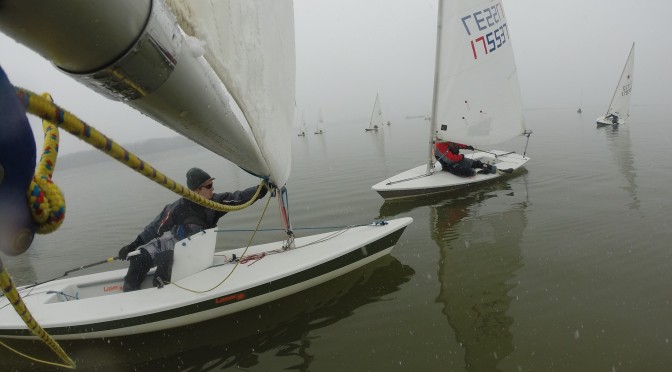Welcome back, one and all, to another season of frostbiting on the Potomac! Congrats to Len for winning the day with another consistent performance today. As has become our custom, the third place finisher writes up a summary of the day’s racing. Here goes:
Winds and Course: The winds today were tricky, coming out of the northwest-ish forecast at about 10 kts, with gusts expected in the high teens. We were racing out in the river, just north of the power plant and starting off to the east side. We ran a total of six Windward / Leewards, two laps a piece, starting and finishing in the middle. In total, we had 18 racers out there today—great start of the season. The breeze was moving around quite a bit as we got closer and closer to the windward mark, which made things interesting throughout the day.
Boat Setup: Nothing special to speak of today regarding how I set up the boat. I didn’t use much vang at all, and for the most part my downhaul was either on too much or too little given the up-and-down velocity.
Starts: The pin was heavily favored all day, and getting off the line in clear air was essential to a good performance. I was surprised at how little congestion there was at the pin-end for most of the starts—often times, the breeze would lighten up and people would only get about half-way to two thirds of the way down the line by the time the gun went off. I focused on staying outside the pin until about 45 seconds, and setting up in the last 25% of the line to get a clean, favorable start. This worked most of the time, aside from one race where my tiller wrapped itself in my mainsheet, and the last race when I was about two seconds early and had to go back.
Upwind: The beats were pretty challenging today, given the often-changing velocity and direction, as well as the low-flying aircraft overhead. I found that for the first four or five races, it paid off to stay a little left of center, and ride the port tack lift up most of the way. Once I was 2/3 s of the way to the mark and things started getting shifty, I found that tacking on pretty much every shift was the way to go. Occasionally, I stayed on the port-tack lift a little longer, and that ended up resulting in losses rather than gains. On the rare occasion that I went out way to the left, I lost velocity to the point that it cost places; also, when I had to go back to re-start in the last race, I ended up really struggling on both beats since I had to navigate dirty air and other boats throughout.
Downwind: Can’t offer much here, as my downwind performance has really fallen off lately. A couple of tips: make sure you keep up your speed coming around that windward mark, rather than worrying too much about having the perfect course straight away (that one was from Len); another lesson learned occurred when messing with Farley coming into the leeward mark in race 2, and I neglected to look over my transom to check the puffs coming, resulting in a brief swim. I’m apparently a slow learner, as it happened to me twice today, both times in the same spot.
Bonus tip: when getting dressed to head out, I noticed both Len and Kevin had on wetsuit hiking pants. Given the water temp was sub-50, I thought to myself “these guys are INSANE; I’m definitely going ‘dry suit’ today”. Only a few minutes later did I notice they had put dry suits on over the hiking pants. Given the way I feel below the waist right now, their approach makes a lot more sense.
Big thanks to Keith and his wife for getting six races off today under challenging conditions. It was great being out on the water again; I look forward to seeing many of you again next time I make it out.

